This blog post was originally published on December 29, 2013 and has been updated on May 26, 2025 for accuracy and up-to-date travel info.
One of my carioca friends once said to me “Não é a minha praia.” Literally translated to, “it’s not my beach,” this expression in English means “it’s not my cup of tea.”
Just as the English love their tea, Brazilians (especially cariocas) looooove their beaches.
In Rio, the beach isn’t just a place to go and soak up some rays. It’s a lifestyle. And there are strict rules that must be followed if you want to fit in.
First things first…
Get to know the “postos”
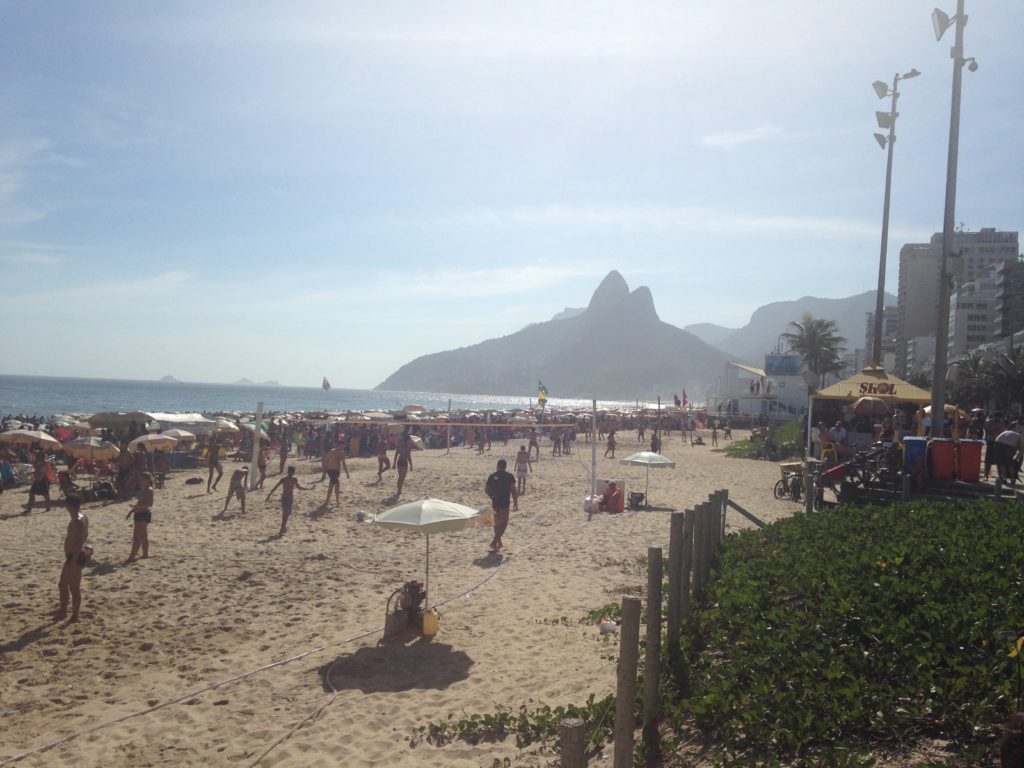
Each beach in Rio has its own “posto.” Postos are used as reference points for locating the different beaches and establishing meetup points. The postos are numbered 1 to 12, with about half a kilometer between each one.
Perhaps more importantly, all of the beaches (or postos) in Rio have their own characteristics and are frequented by different crowds. As Frommers puts it,
beaches are to Rio what cafes are to Paris.”
While Copacabana may be the most famous beach in Rio, it’s definitely not the coolest amongst cariocas or Rio residents. Posto 9 (Ipanema beach) is the place to be and be seen. On a sunny weekend day, it gets so packed that you can’t even see the sand.
Between Posto 8 and 9 (also Ipanema) is the gay beach, made distinctly obvious by the rainbow flags waving about.
Posto 12, located in the wealthiest neighborhood of Rio, Leblon, is less packed than Ipanema, but still quite hip. This family-friendly posto is (also) filled with hordes of beautiful people, so get your binoculars ready! Joking lol.
If you wanna have a more low-key beach day (with fewer people) head to Posto 1 (Leme beach).
Prefer to escape the crowds entirely?
If you don’t mind venturing out of the city a bit, head to Barra da Tijuca. The beaches there are wider and much less crowded than city beaches, with bigger waves. They’re also safer (since there are no favelas in Barra da Tijuca). Take a look:
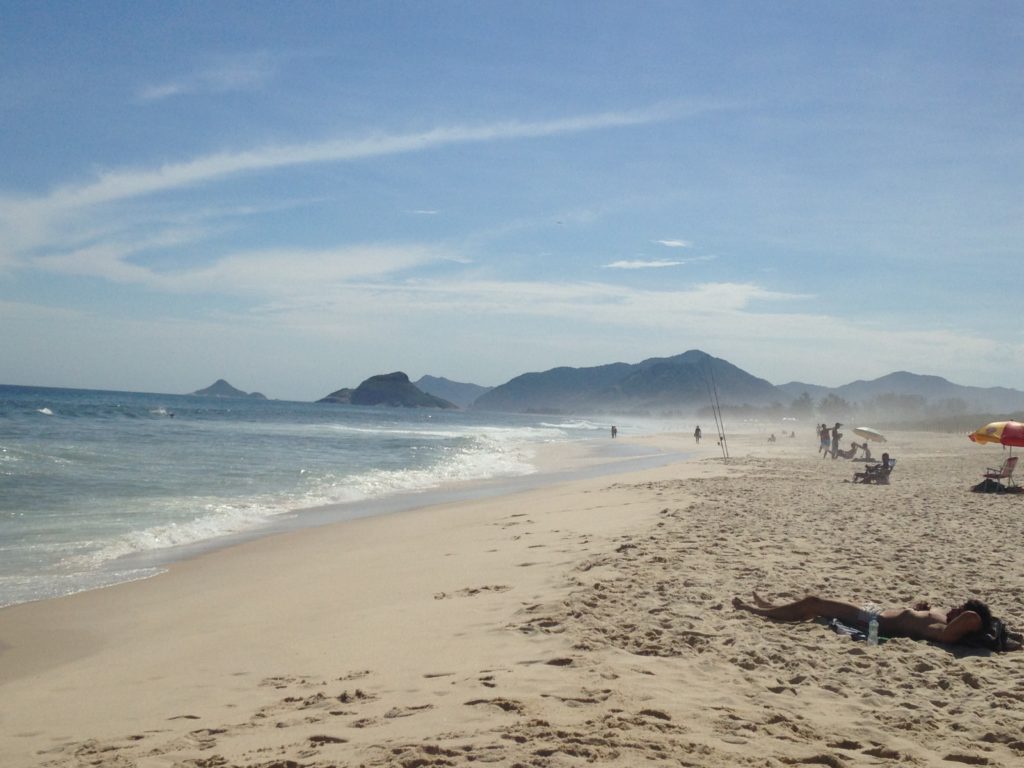
Much more chill than the beaches in Rio.
Update your swimwear
It’s always easy to spot the gringos on the beaches of Rio. They’re the ones that don’t show enough skin or as the Brazilians joke, wear fraldas (diapers).
Brazilians, on the other hand, prefer to show as much skin as humanely possible without going nude or topless (it’s actually illegal to do so, so don’t try!).
The bikini bottom cuts range from flirty (covering about half the bum) to thong aka fio dental in Portuguese (which also means “dental floss”).
And the best part? In Rio, it doesn’t matter if you’re a 90-year old grandmother or 200-pounds overweight: Women of all ages and sizes sport the same barely-there bikinis.
In the US, women tend to have so much shame about their bodies, especially if they are over a certain weight or past a certain age. It’s refreshing that in Brazil, body shame doesn’t seem to exist. Or if it does, it certainly doesn’t exist on the beaches!
While surfers wear board shorts, most men wear sunga, which resembles the speedo (hey, they gotta work on their tans too!).
I’ve even seen men wearing those tiny little bottoms (and nothing else) in grocery stores…I kid you not. Gotta love Rio.
Whatever you wear, do as the Brazilians do and leave your body hang-ups at home. The more confidence you have on the beaches of Rio, the more you’ll fit in.
When I first got to Rio, I wore my “fralda” to the beach… but I soon converted to the Brazilian bottom.
I’ll admit: I was definitely uncomfortable revealing so much skin at first. But by the time I left Rio, I couldn’t imagine wearing anything else to the beach (btw, I’ve since dumped those fraldas in the trash!).
Ditch the towel (and everything else)
Less is more in Rio (and I’m not just talking about swimsuit fabric). Perhaps partially for safety reasons (more on that in a bit), cariocas don’t bring much of anything to the beach. No hefty beach bags or coolers welcome.
Many people just bring sarongs, also known as kangas, which double as beach chairs (these are sold all along the beach boardwalk in case you left yours at home). Whatever you do, just don’t bring a towel. It’s a total faux pas on the beaches of Rio.
Lose your bikini top in the turbulent waters? Not to worry. Hard-working men brace the sun’s scorching rays and pace back and forth along the beaches selling everything from jewelry to bikinis to kangas.
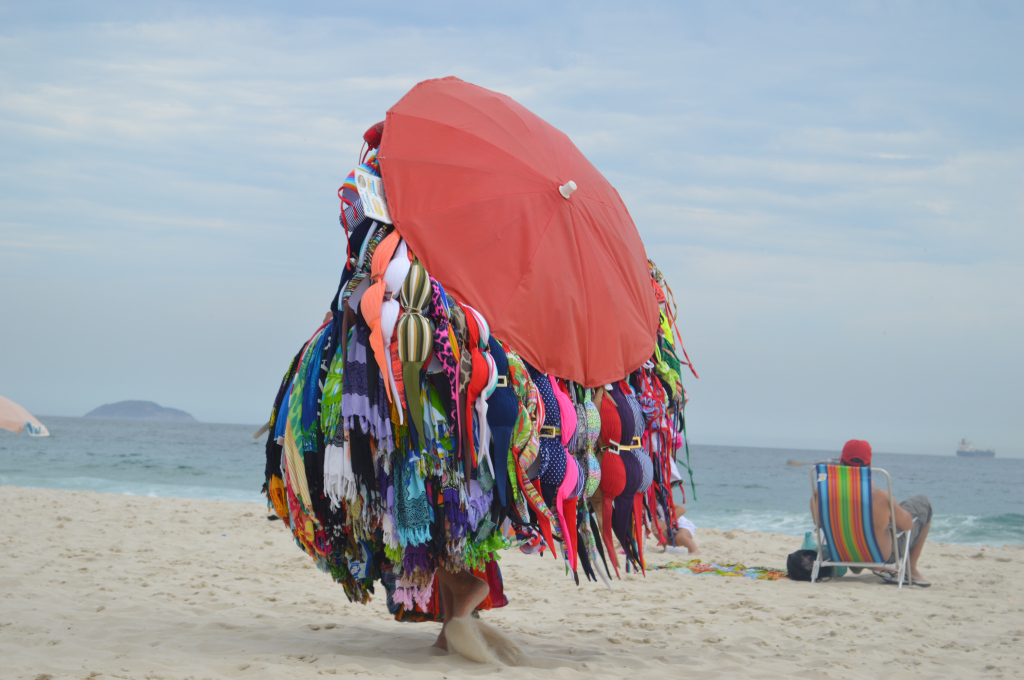
That photo was from 2014 but the bikini vendors were still there when I went back in 2023:

Hit up the “barracas”
It’s almost disrespectful to bring your own food or drinks to the beach in Rio. So if you want to fit in, leave that cooler at home. Fortunately, inexpensive food and drinks are easy to find on the beaches of Rio.
The beach sidewalk in Copacabana is lined with restaurants, where you can sit down to eat or order food to take away.
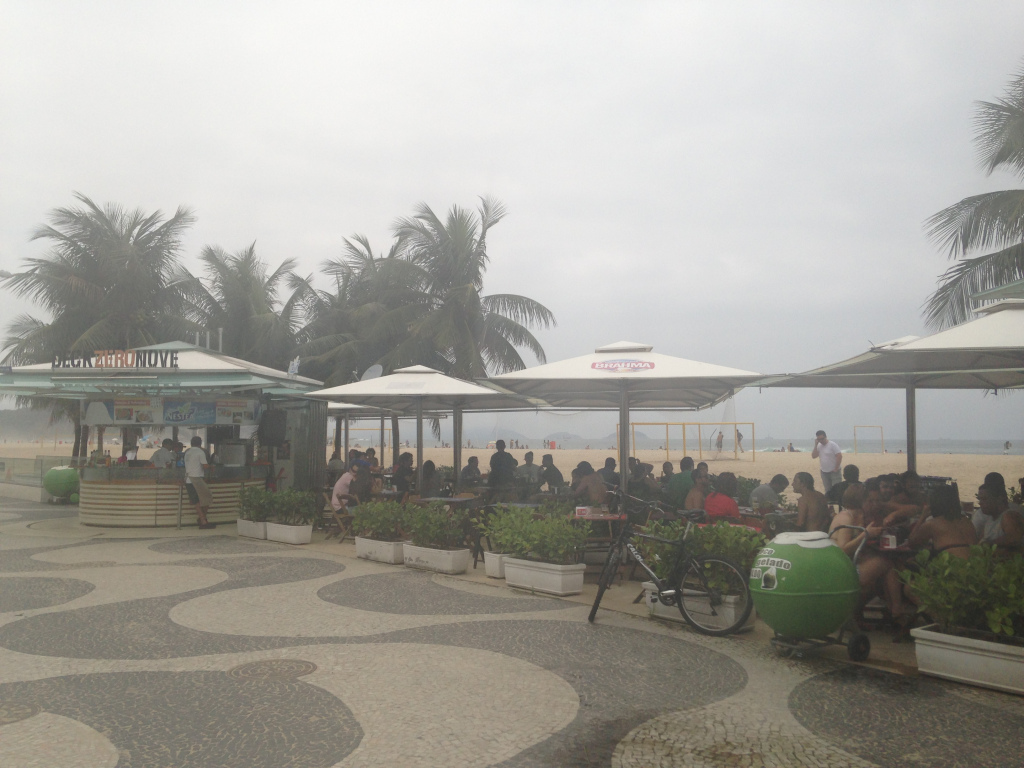
But don’t worry… you don’t actually have to leave the beach to get food (or drinks) in Rio (God forbid). All along the beaches are small tents (called barracas), where you can buy drinks and snacks or rent chairs and umbrellas. When I was there in 2014, you could rent a chair and umbrella for just five reais a day (like one dollar).
Now? Well, as of 2024, the price is apparently 7-12 reais for a chair and 15-30 reais for an umbrella. At least according to Reddit:

Crazy how much the prices have gone up. All the same, it’s still much cheaper than the US.

Don’t feel like lifting your bum off the sand? Food vendors will come right to you. Serving snacks like queijo coalhho (cheese kebabs), acai, mate com limão (iced tea), and of course iced cold agua de coco (coconut water).
Get your bronze on
Given how white I am, I didn’t partake in much sunbathing (I’m the one covered in long sleeves, a wide-brimmed hat and sittng under the umbrella all day long lol). But if you *do* like sunbathing, Rio is the place to do it.
Oh and don’t hide those tan lines! Because in Brazil, the more tan lines you have (and the more pronounced they are), the better.
Be social
Introverts, be warned: You’re unlikely to ever see a Brazilian reading at the beach or listening to music with headphones on. The beach in Rio is reserved for socializing with friends… impromptu football and volleyball games… chatting with friendly beach vendors… and people-watching.
Many beach-goers simply stand (what seems like all day long) with their hands on their hips, checking out the scene. Suffice it to say that the beach in Rio is many things, but it is never boring.
If you want to work on your beach bod, there are exercise stations set up at each posto sidewalk. They even come with stretching guides for exercise-goers.
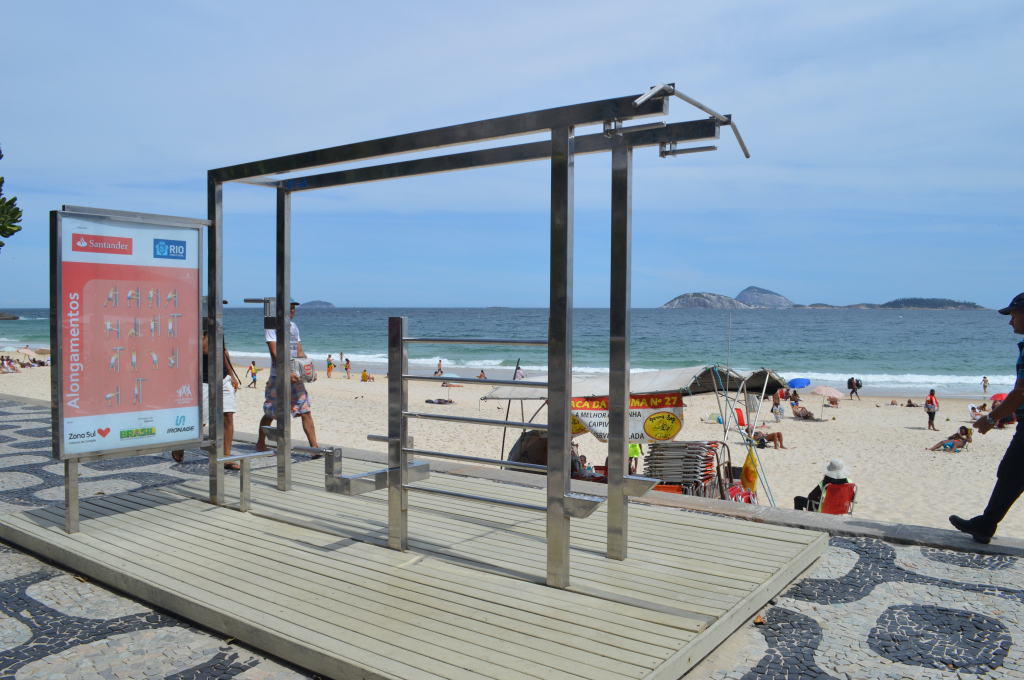
Is it any wonder that there are so many cariocas with killer beach bods?
Be safe (and watch your belongings like a hawk)
The one downside to Rio beach culture? It’s not very safe (at least not in the Zona Sul… Barra da Tijuca is quite safe).
Beaches in the Zona Sul are subject to arrastões, which is when gangs of people surround an area and steal everything in sight. The beach turns into total mayhem.
So seriously. Leave your valuables at home! It’s not worth the risk. My old roommate (who is English) made the mistake of bringing his iPad to the beach during one of his first weeks in Rio. Surprise, surprise: It was stolen. He ended up getting it back, but only after fighting for it (which I definitely don’t recommend!).
If you’re like me and you absolutely must bring your phone with you, then at least take a small bag and ask some trustworthy people to watch it if you go in the water (and make sure it’s in their direct line of sight). Or better yet, get a plastic case for it and bring it in the water with you.
Bargain like a carioca
Chances are (at least if you’ve read this blog post), you’ll want to buy or rent something on the beach at some point. The only way to not get the gringo price is to speak a bit of Portuguese (and know when you’re being ripped off).
Use your best judgement – if something sounds unreasonable, it probably is. But keep in mind that the beaches in Leblon and Ipanema are going to be more expensive than neighboring beaches to the east (like Copacabana and Leme).
Here are a few words and phrases that will help you get the local price:
cadeira – chair
guarda- sol – umbrella (for the sun)
kanga – sarong (the Brazilian version of the towel, which also doubles as a cover-up)
fio dental – thong bikini
maté – sweet iced tea
agua de coco bem gelada – ice-cold coconut water
Cuanto custa isso? (bonus points if you can pronounce it with a carioca accent – “quan- toh cush – tah) – how much is this?
Você ta me dando o preço gringo, cara? Are you giving me the gringo price, dude?
Me dá o preço carioca – give me the carioca price
Eu tenho apenas 5 reais – I only have 5 reais
Onde fica o banheiro mais proximo? Where is the closest bathroom?
Quero – I want
Stroll along the boardwalk
If you want to get up and stretch your legs, go for a stroll along the boardwalk that runs parallel to the beach. I especially recommend this on Sundays, when the street is closed off to cars and replaced by bikers, rollerbladers, joggers and even bands performing mini concerts. Like so…
Clap at sunset
Don’t miss the sunset on the beach. It’s incredible. Just take a look at the sunset in Ipanema (this photo was from 2023… as you can see, the quality is much better than my previous photos lol):
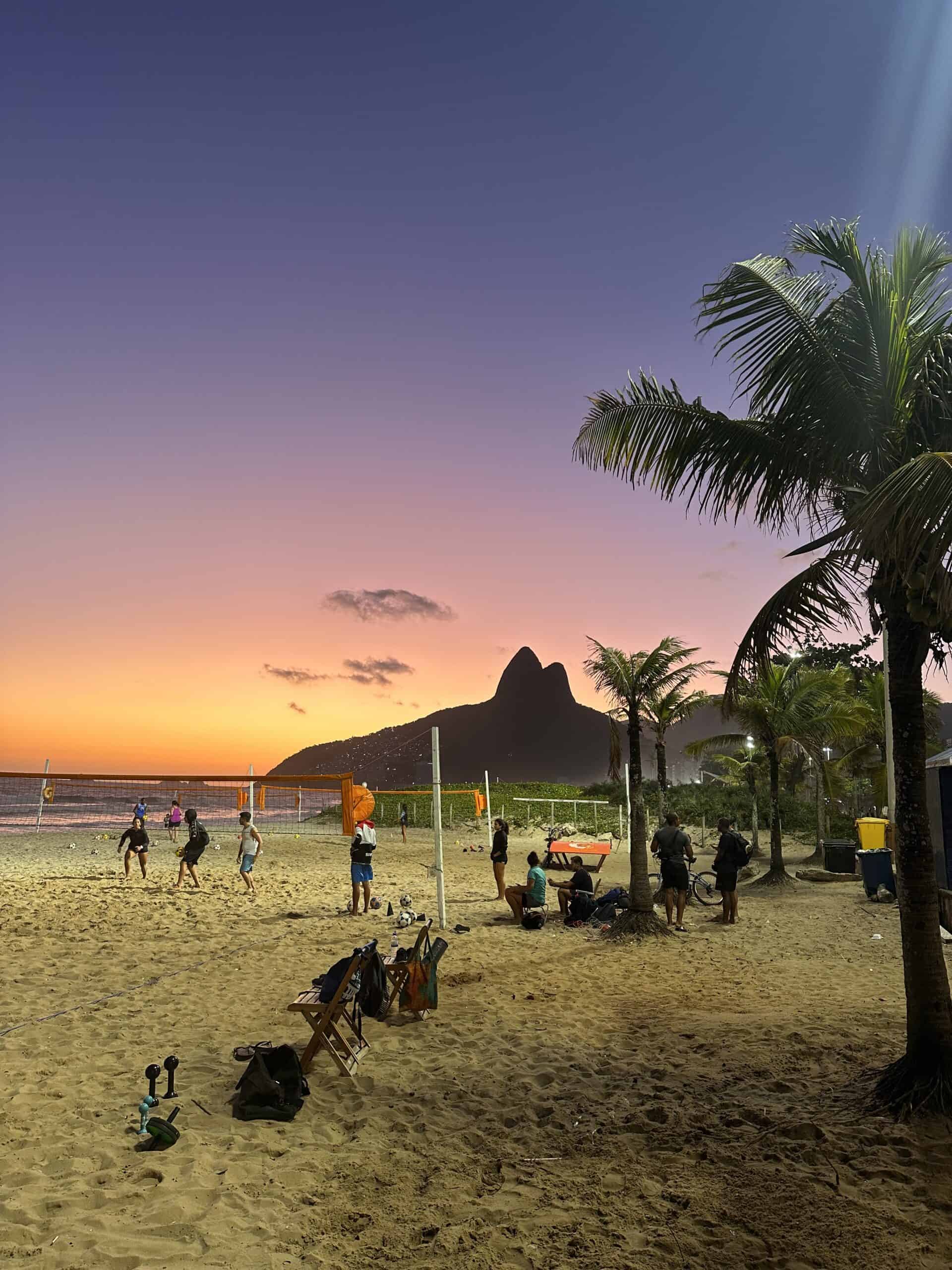
Arpoador, a rocky area between Copacabana and Ipanema, has another great sunset spot.
And the best part is that, every day without fail, people clap and cheer as soon as the sun sneaks below the mountains. Here’s a preview for ya:
A perfect example of how happy-go-lucky Brazilians appreciate the little things in life.
Have you been to the beach in Rio before? What was your experience? Would love to hear. Share in the comments below!
